Trent Lupton Portfolio
December 6, 2019
More than two thousand years ago, the Greek fabulist Aesop said that persuasion is more effective than force. I have found that to be true over the past semester. In English 117, I have learned how to be persuasive using numerous internet techniques that have challenged me intellectually and conceptually. Furthermore, I have gained skills that I had no idea existed just a few months ago. The internet is used throughout American society today, and being able to compose meaningful arguments on the internet has only now become a skill that I have acquired.
I have never thought of myself as being a creative person, but I have certainly worked creatively throughout this course. When I created GIFs and memes, I initially stalled trying to find topics to center my work on. I searched for hours while completing these assignments to find a subject that I found interesting and compelling, but in the end I was able to discover topics that caught my interest and I could expand upon in a meaningful way. I also think I worked creatively when designing my app, which I made to be a game-like simulation for the user to navigate the problems with the American lobbying system. Although I am certainly not the most creative individual in this class, I have amazed myself with my abilities to create unique pieces of argument in this class. Creativity to me is not necessarily making something unimaginable; creativity is bringing your own form of originality to a given topic. I am pleased and proud of my accomplishing these projects throughout the course where I acted creatively. Designing GIFs and memes, I incorporated my own taste of comedy and made things that I found amusing, which was a lot of fun. One of my memes was a parody of the movie cover of Step Brothers, which is a favorite movie of mine. I made a political meme out of the movie cover that I found to be very amusing, but I had no ability to make memes using Adobe Photoshop prior to this class. Since learning this skill, I have made memes in my free time using pictures I have saved of my friends and sharing them. Gaining this creative ability was certainly not an expected outcome that I had from taking this class, but I have enjoyed it immensely.
Additionally, I have become more adaptable after taking this course. Quite obviously, things do not always work out as expected but I have seen this to be true in English 117. Looking back on the semester, I can think of only a few instances where the project I began working on looked anything similar to how I expected it. I define adaptability as having to start fresh when it is not especially convenient to do so, which I have done in this class. My audio essay was initially going to be about gun control in America- it instead evolved into an essay about social media used as news. This change occurred when I read discussions for and against gun control online and seeing that many of the sources being cited were emotional ploys found on social media. I realized that I could create a stronger persuasive piece if I changed course, which I view as an adaption. More generally, I adapted throughout the process of completing each of my assignments in this course. Relying on feedback from my peers and Professor Anderson, I changed each of my projects at some point to fine-tune them and create forceful pieces of argument.
Collaboration was a major aspect of this course as well. I worked directly or indirectly with peers and Professor Anderson on each of my projects, relying on feedback and suggestions given to me. Working with others made me realize the importance of learning from others and taking advice to improve upon my work. It was always beneficial to talk with classmates and learn what was working well for their assignments, and finding a way to incorporate useful takeaways into my own projects.
It was difficult for me to incorporate different forms of media into my arguments throughout the class because this was entirely unfamiliar to me before the class. Completing the Twitter Analysis was my first time utilizing social media in an argument. I used actual tweets to strengthen my analysis, which was fun and thought provoking. Drafting my second assignment, the audio essay, led to me developing a verbal argument that relied on the support of inserted media clips. Toward the end of the semester, when working on memes and GIFs, I used Adobe Photoshop which allowed me to be able to create an argument with images that elicited emotions. Succeeding at using numerous forms of media in argumentation will aid me in crafting effective claims moving forward.
I have learned a great deal this semester and I look forward to showing my progression.
Portfolio Video
The portfolio video that I created illustrated how I composed my first two projects, the Twitter Report and Audio Essay. I chose to focus my video on these two projects because they were both very unique to me. I had no experience creating projects similar to any of the projects I completed for this class, but these two were special because they forced me to think imaginatively.
My first video captured had good audio but was lacking in visual appeals. I needed to improve how I overlaid videos and images with my commentating, because some of my videos did not do a great job supporting what I was saying. I also had some videos that moved too quickly and took focus away from the messages I was trying to convey.
Here is the link to my Original Portfolio Video.
I improved my video after receiving feedback and watching the video several times. I made my visuals more focused and refrained from scrolling quickly through pages on video. Deciding to have more time allocated to still images, I hope my video is increasingly concentrated on the takeaways I gained from the projects.
This is my finished portfolio video:
Twitter Report
The first project I completed in English 117 was the Twitter Report. I identified a hashtag that attracted attention and examined the usage of tweets containing the hashtag. I chose the hashtag #Biden because Joe Biden was the democratic frontrunner, and also in the news relating to sexual misconduct allegations against him. I thought it would be interesting to see what tweets directed at him argued.
I used TAGs, where I could track tweets containing #Biden. I instructed the software to update every hour with #Biden and to exclude #RT so I would not see the same material multiple times. After a week of data collection, and I sorted over 100 tweets into the categories of- the tweet’s opinion of Biden, the political stance, and the main rhetorical appeal that was being used.
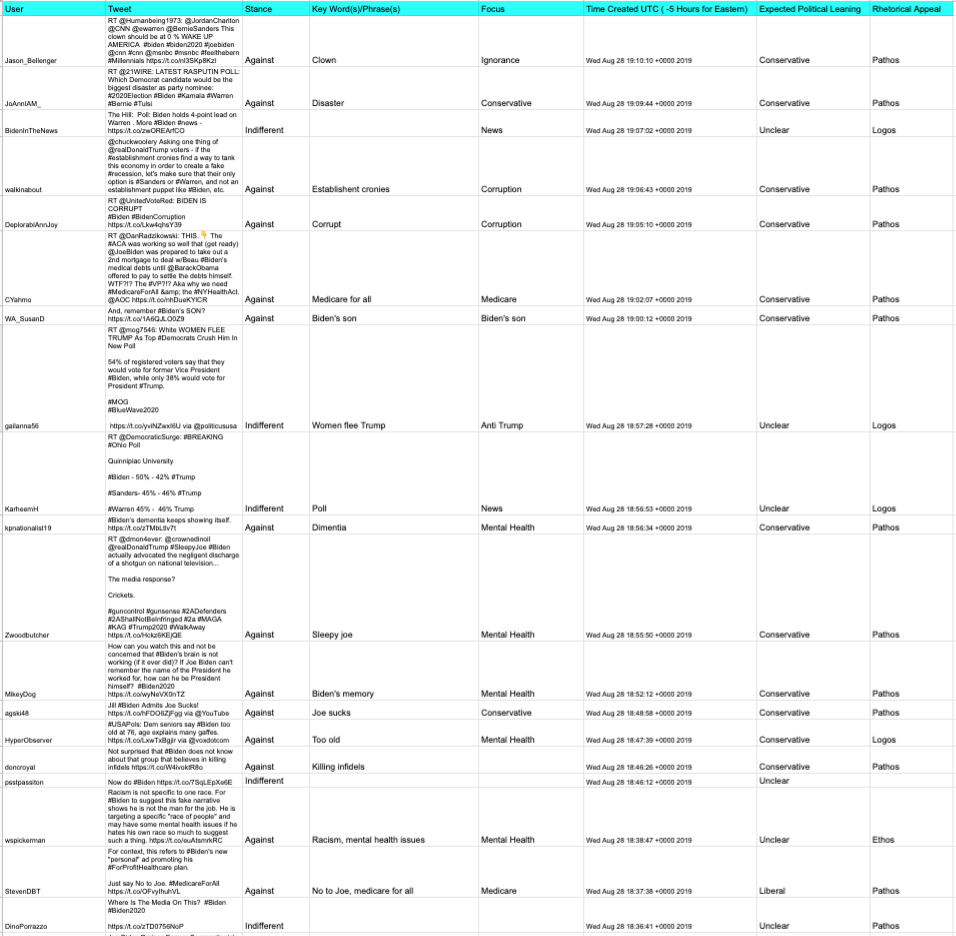
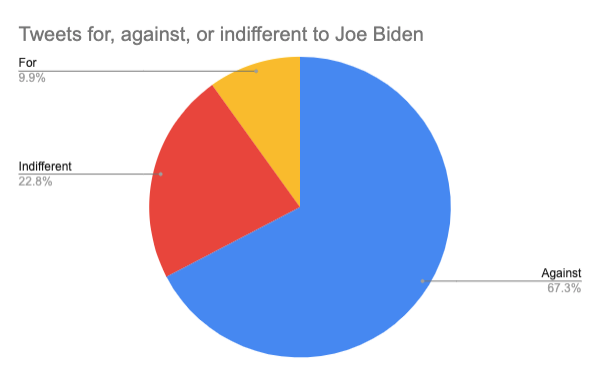 I found that a recurring theme in many of the tweets was attacking Joe Biden for behaving inappropriately toward women, and being too old and in bad mental health to run for office. I was very shocked to see so many negative, personal attacks against the former vice president rather than political discourse.
I found that a recurring theme in many of the tweets was attacking Joe Biden for behaving inappropriately toward women, and being too old and in bad mental health to run for office. I was very shocked to see so many negative, personal attacks against the former vice president rather than political discourse.
More than two-thirds of tweets I examined had something bad to say about Biden. Less than 10 percent said something positive about Biden, and the remainder were indifferent- usually expressing some sort of fact or statistic.
The political affiliation of the Twitter user did not determine how they felt about Joe Biden either, which I found to be surprising.
 Many Twitter users that I identified as liberal-leaning were arguably more critical of Joe Biden than the conservative-leaning tweeters. Twitter users who were supportive of other Democratic candidates such Bernie Sanders, Elizabeth Warren, and even centrists like Pete Buttigieg, called out Biden for being "gropey" and "senile."
Many Twitter users that I identified as liberal-leaning were arguably more critical of Joe Biden than the conservative-leaning tweeters. Twitter users who were supportive of other Democratic candidates such Bernie Sanders, Elizabeth Warren, and even centrists like Pete Buttigieg, called out Biden for being "gropey" and "senile."
From this assignment I have concluded that arguments on the internet are often centered on emotions and sentiments. Facts are not utilized as basis for arguments on social media sites, where it is easy to blurt out what is on the user's mind without fact checking.
This is my Original Twitter Report.
I revised my twitter report to incorporate a Tweet that was calling Joe Biden "gropey" to illustrate the usage of the term to describe him. I also took out unneeded jargon and a graph that did little to add on to my argument.
This is my finished Twitter Report.
The Twitter Report was a great project to have at the start of this course. I studied what these Twitter users argued and how they argued it. Having this understanding gave me a better appreciation for the methods of argument that exist using the internet, which I further explored in my following projects.
Audio Essay
The audio essay was a challenge for me because I had never written an essay that was meant to be read as a script. I struggled at first to write concisely in a way that presented an argument verbally. I decided to create my audio essay about the topic of social media as a source of news. I thought this was relevant because of social media’s importance today, and how Donald Trump uses social media politically.
 I used Audio Hijack to rip audio content from videos and make audio files on my computer that I could insert into audacity to flow with my own voice recordings. This strengthened my audio essay because I included evidence directly from news sites and ted talks. Including other voices made my essay more captivating.
I used Audio Hijack to rip audio content from videos and make audio files on my computer that I could insert into audacity to flow with my own voice recordings. This strengthened my audio essay because I included evidence directly from news sites and ted talks. Including other voices made my essay more captivating.
I wrote a script of what I would say, and I included the script of the videos I included to ensure it all worked well together. I had to revise my script several times to cut back on words to create a strong argument without being full of needless words. Recording myself, listening to the recording, and going back to revise my script made me notice how wordy I can be. I realized the difference between writing for speaking - and writing for an essay to be read.
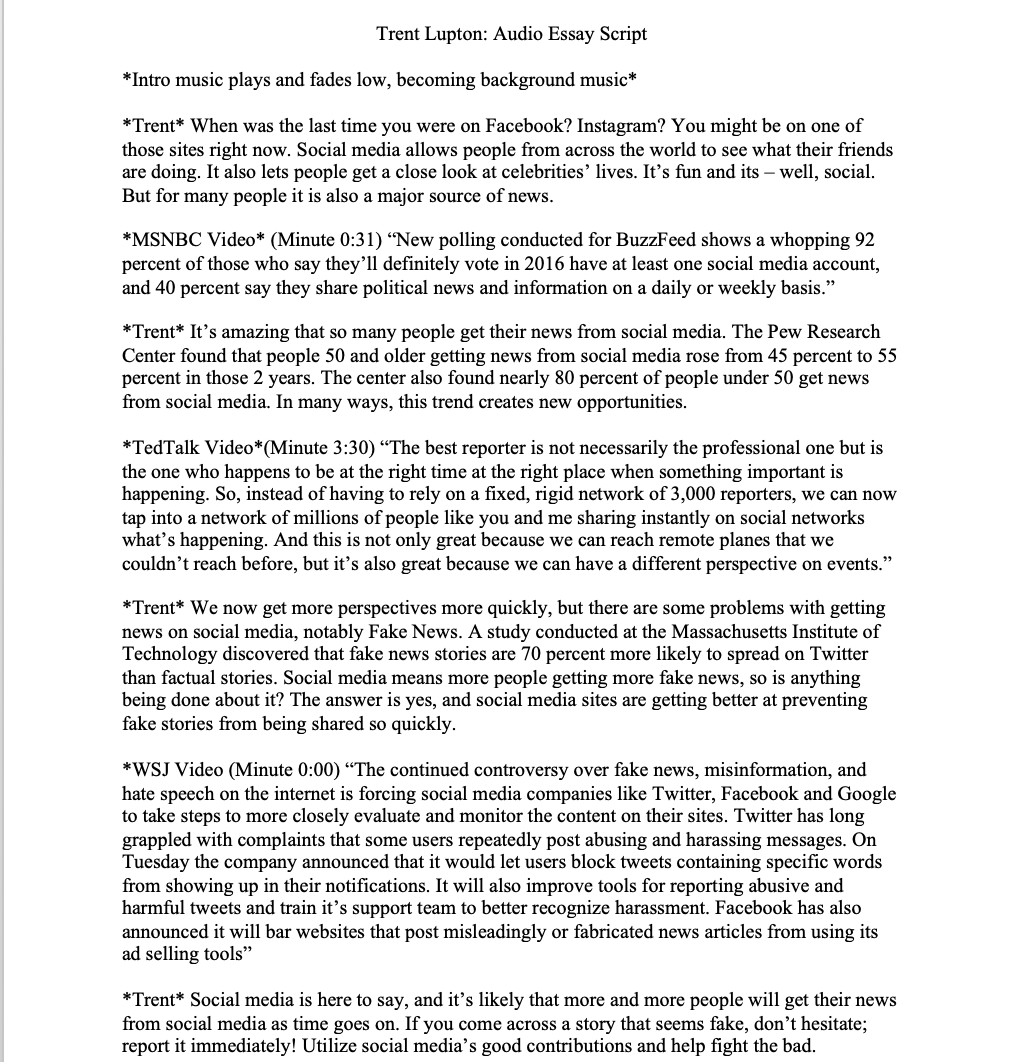
This is my original audio essay:
I revised my original audio essay to delete unneeded segments, further reducing my words. I adjusted the audio levels of my inserted clips and faded the music at the beginning and end. I needed to revise the audio levels of certain clips so the volume flowed smoothly, which I did using the Envelope tool in audacity.
Reading and recording myself several times made me understand the extensive process of getting my voice and tone exactly how I wanted it for the finished audio essay. I realized the importance of speaking with emphasis and being concise for an audio essay, because I would lose track of what I was saying when I would listen to myself read lengthy sentences. Differing from more formal essays, audio essays need to be composed with brief sentences that get to the point without the formality and unnecessary fluff that I apply to my traditional essays. I relied on feedback from my peers who listened to my audio essay and Professor Anderson's useful takeaways. This collaboration helped me to strengthen my argument by speaking with brevity that got to the point quickly.
This is my finished audio essay:
This assignment taught me how to write and speak argumentatively in a way that wasn’t wordy and caught a listener’s attention. I learned a lot from continuously editing my script and recordings to speak in a way that conveyed a stronger argument. Understanding how to rip audio files, trim a video, and edit the sounds will allow me to use Audacity and other editing softwares in a way that is compelling moving forward.
Podcast
Audio arguments are similar across audio essays and podcasts in that they incorporate audio files pulled from the internet. Both audio essays and podcasts use audio from videos and sound effects to make the information more easily understood to listeners. A major difference, however, is that audio essays are planned out and scripted, while podcasts are very conversational and tend to not follow a rigid script. Podcasts also usually have a panel of speakers that share different thoughts and ideas.
Collaboration was key when working on the podcast assignment. I worked in a group to create my podcast, and we decided to focus our podcast on social media's impact on politics. Each of the five of us had a focus point to bring to the discussion. We collaborated to create a smooth flowing discussion that was not entirely prompted but had a structure to it that made sense. I had the role of host for the podcast, so it was important that I knew when to interject and introduce a new topic for discussion. I worked diligently with my group to fine tune my interjections.
The finished podcast turned out better than I expected. Our conversation flowed very well and all of our points that we had prepared added value to the discussion. We included an inserted media clip from a video, but decided to exclude other videos that had originally been planned because our five voices provided a good amount of variety on their own. We adapted while planning our podcast initially because we narrowed our topic down to social media used for political campaigns, although we originally planned to have our topic be social media's impact on society in general. We adapted throughout the planning of our podcast to allow each of us a good amount of time to speak, and adapted during the actual recording of our podcast as we went along. There was a great deal of adaptation during the recording of our podcast because it was almost entirely unscripted.
This is the recording of my group's podcast, which I have edited to reduce loud background noises when there was no speaking from the group:
Differing from the audio essay, I was not so concerned about speaking with brevity when recording the podcast. That is because the audio essay was very planned and scheduled, whereas the podcast was meant to flow like a normal conversation. A similarity between the two was the editing process at the end. I inserted my podcast audio file into audacity and removed some segments as I had done with the audio essay. Both the audio essay and my podcast are argumentative through sound, yet I was not worried about speaking with emphasis and persuasion nearly as much with the podcast.
The podcast was an important lesson in the value of being persuasive in a way that differed from the audio essay, which was providing entertainment by creating an entertaining conversation that felt genuine and was easy to listen to. I enjoyed collaborating with my group and creating the podcast.
App Argument
I created a mobile app design using Adobe XD that focused on the American lobbyist system. I originally wanted to make an app that was a sort of news site that offered a variety of perspectives, but I realized this would not so much present an argument. I adapted and transitioned to the topic of lobbying because I believe lobbying is a corrupt part of our government.
I started off by thinking about why I believe lobbying is corrupt. I thought about the power of some lobbying groups such as the NRA and how much power they have. I also thought back to hearing that many lobbyists were once politicians. I began researching facts about lobbyists, and then I researched laws contradicting the lobbying facts. My app was set up so that I would present the viewer with a law that I elaborated on, and would then discuss how the lobbying system gets around those laws on the next screen.
This is my Original App.
I liked how my app turned out but felt I could make my argument stronger still. I made my app function as more of a game by adding questions that seem to have an obvious answer based on the laws I present, and I then showed the information about lobbying. I also improved the functioning of the app prototype by figuring out how to have a button to click on the screen to lead on to the next screen. This made my argument much more affective.
Below is my finished app:
Creating an app argument was significant for me because it was not nearly as difficult as I had expected once I got things rolling. I also appreciate the power of making an argument over an app. Having the interactive interface in which the user is actively using the app offers a form of argument that is so much more intense than reading a paper, in my opinion. Using my own app as an example, I was able to present an argument against lobbying with less depth than a paper, but the ability to scroll through and see that your response to my quiz questions are wrong strengthens the understanding of the problems with lobbying.
This app was probably my most creative product to come out of this class. I adapted throughout the formation of the app to make the argument more compelling, notably when I added the question feature. This feature was Professor Anderson's idea, and I used this suggestion to make my argument better. My app would not have the force it achieves from this feature if I had not relied on collaboration.
Meme Images
Adobe Photoshop was very difficult for me and required a lot of patience. I had to take a sizable amount of time to develop abilities to create memes, but I really enjoyed it. Throughout the experience as I encountered problems, I would go back and address these issues by collaborating with classmates, consulting Professor Anderson, watching Youtube videos, and reading over the daily tasks found on the website. I also would utilize the feedback I received from Professor Anderson for each of my assignments to improve my work.
I created three memes, the first of which was meant to be humorous. I used a Winnie the Pooh template that I had seen before on meme accounts, and made a joke about UNC Quidditch being better than basketball and football. This was the first meme I created and really only required adding text to an image. It was easy and gave me some confidence moving forward.
The second meme was a parody of the cover of Step Brothers. I found images of Russian President Vladimir Putin and Donald Trump, cut out their faces to exclude the backgrounds of their photos, and inserted them on top of the faces of Will Ferrel and John C. Riley. I thought this was a funny picture and made a subtle argument about their political ties.
My third meme was more of an argumentative meme than the previous two. I put pictures of Alexandria Ocasio-Cortez, Mark Zuckerberg and Donald Trump on the same canvas and emphasized how very little has been done about fake news on Facebook. Including AOC was important because she gained attention for her interrogation of Zuckerberg only a few weeks before I created the meme.

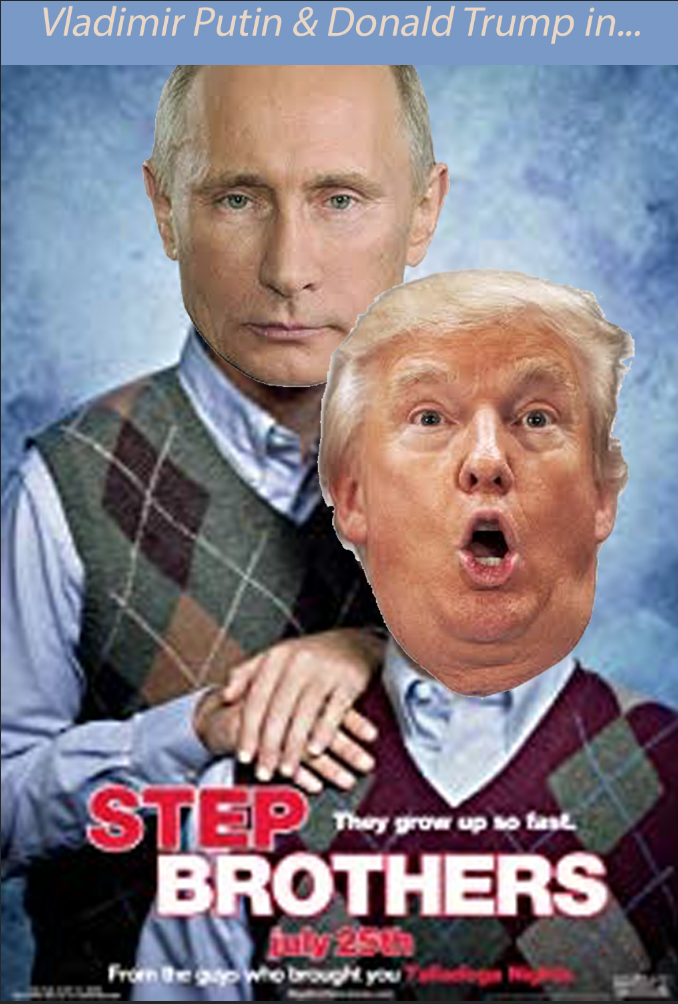
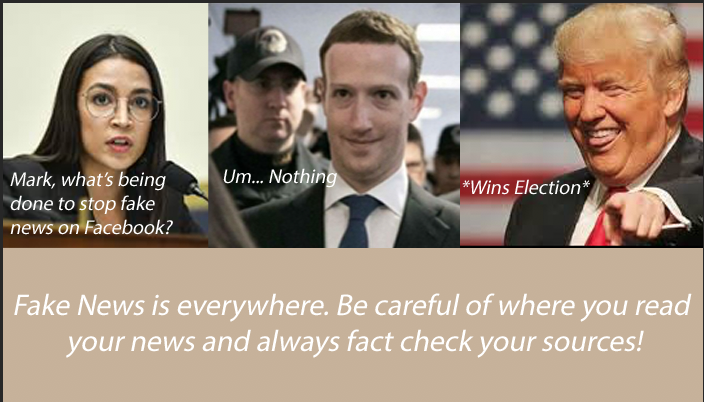
I revised my second meme to add more words, making the reference more effective. I replaced "Step Brothers" with "Step Presidents," and additionally added references to Brexit and the 2016 general election on November 8th.
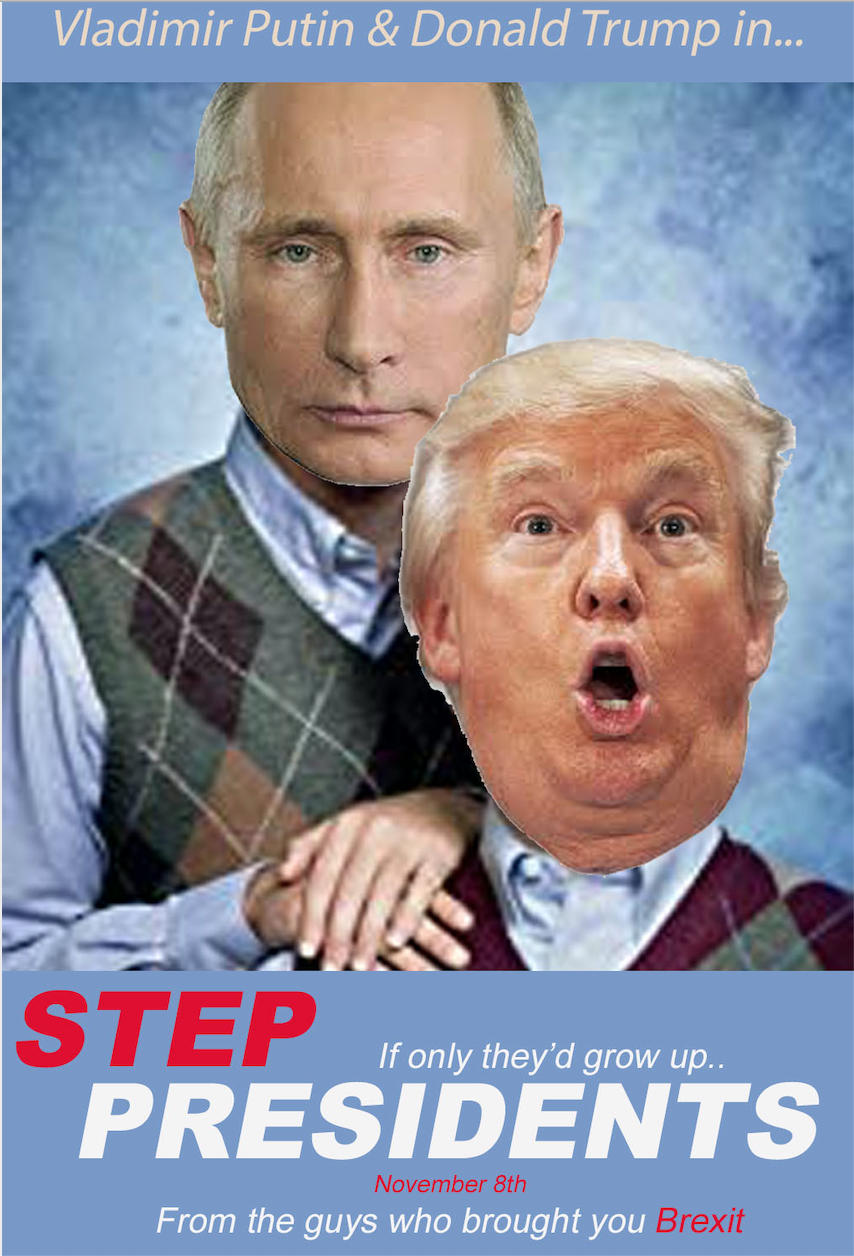
Looking over my classmate's memes, I was a fan of Alex Beal's meme. His meme caught my attention because it shows a man looking at a computer with a thought bubble which reads "the internet is so great at keeping me in the know," while the image shows destruction outside the window. I think this meme illustrates the problem that many have using technology to keep up with things going on but do not pay attention to the real world which surrounds them.
These memes (and my GIFs that follow) offer a strong argument with few words and rely heavily on visual appeals. Seeing an argument rather than reading or hearing it is its own unique form of persuasion. Using my "Step Presidents" meme as an example, I am able to present Putin and Trump as being connected with very few words; the image does the work. Trump's face that I chose looks ridiculous, while Putin's face is serious and over Trump's. My choice of faces and how I positioned the faces make Trump look like a fool who is under Putin's influence. I would need far more than a dozen words to make this comparison if I were arguing in an essay.
Animated GIFs
I created GIFs using the same software I used to make memes, which was Adobe Photoshop. I used videos for two of my memes; one was a downloaded video from the internet, while the other was a screen recording that I made. I inserted these video files into Photoshop, broke the videos down into frames and added text. For my second meme, shown in the middle below, I downloaded a few separate images and made them fade in an out. I added a large red "x" over an image of the woman drinking a class of wine.
The first GIF was made using a video of Dwight from the TV show The Office. I had a lot of trouble during class registration and was only able to add one class to my shopping cart on that day, so this GIF was a reference to my frustration. I liked using this creative outlet to make something I could laugh about while it meant a great deal to me personally.
The second GIF is meant to argue the absurdity of not being allowed to drink at 18 in America. I show transitioning images of teenagers voting, serving in the military, driving, buying guns, but not being allowed to drink a glass of wine. Showing the many things that 18 year olds are allowed to do in our country, followed by showing that alcohol cannot be legally consumed at that age, forcefully points to the ludicrousness of 21 being the drinking age.
My final GIF is a screen recorded video of me typing into Google "news in America." I took a separate recording of results on Google after I typed "gun shooting news from this year," and altered the search box to read "news in America." I put these two videos together to show me searching for news and seeing several shootings this year to stress the number of mass shootings in America.
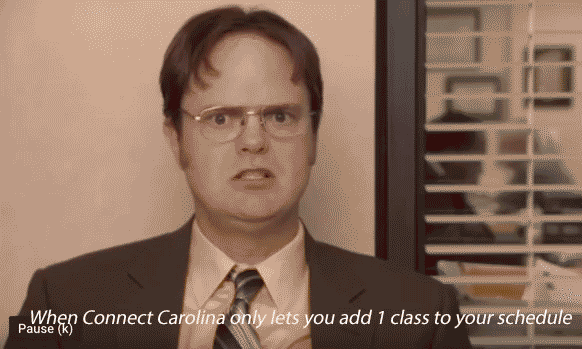
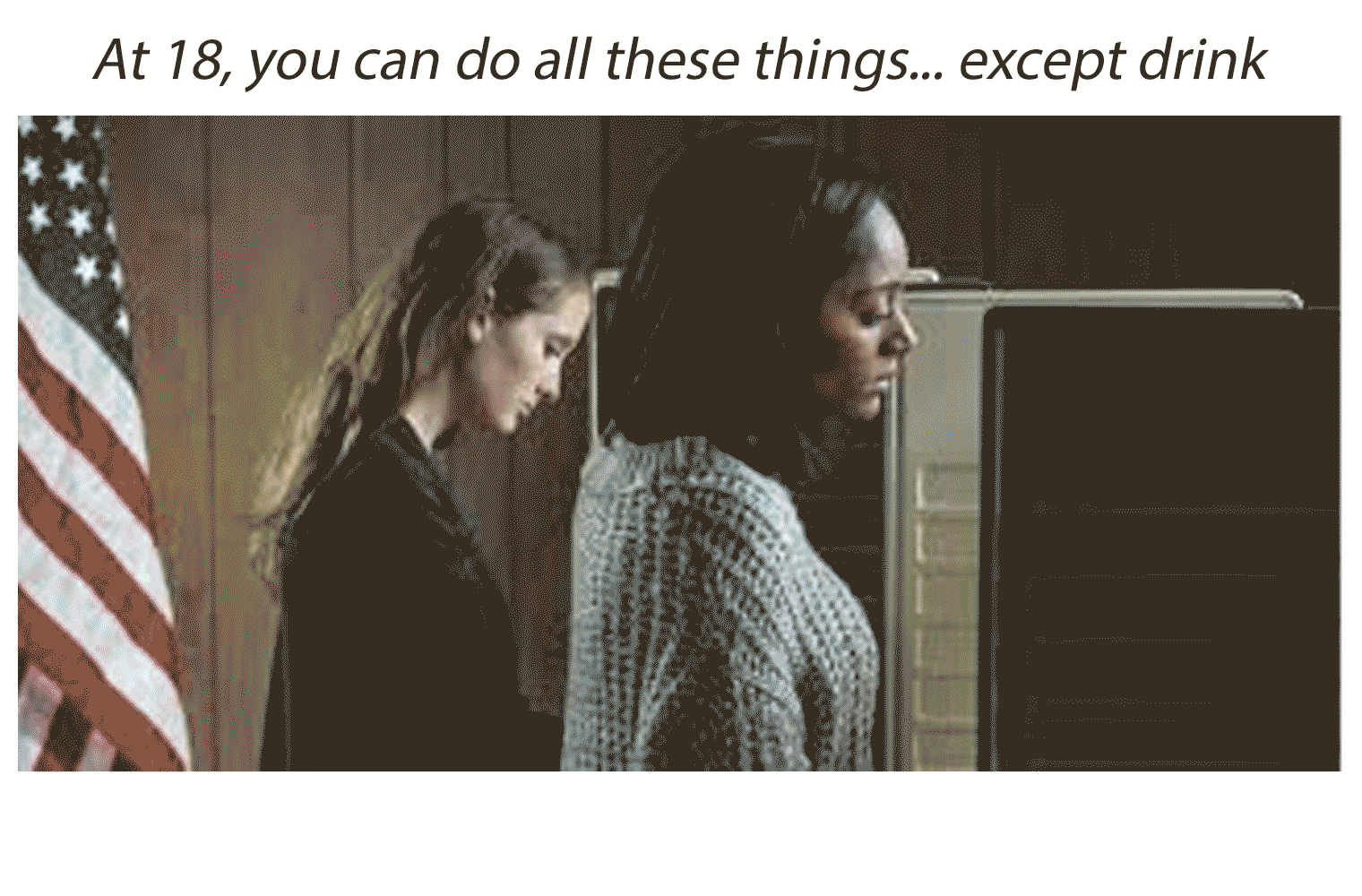
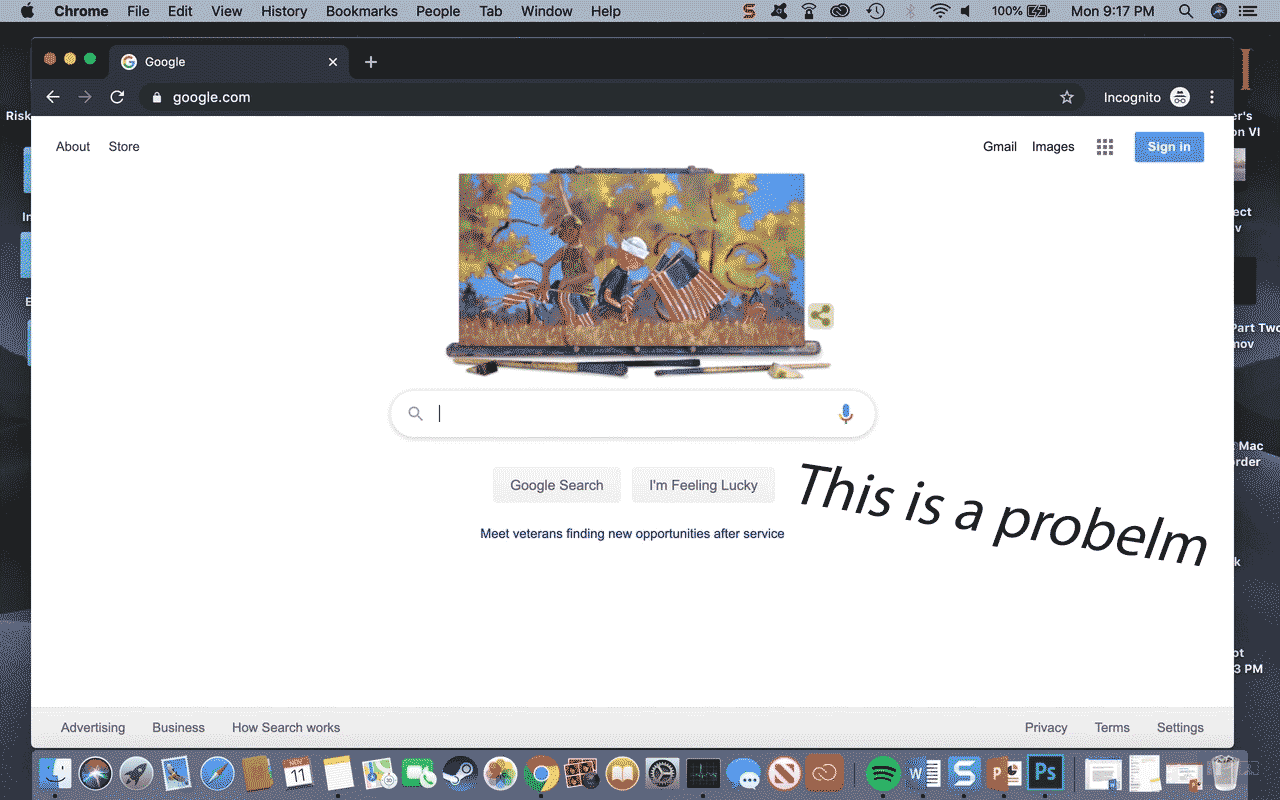
I revised my first meme of Dwight from The Office. I added an image of a flame to the last 4 frames, and I enlarged the flame slightly in the frames to create a growing affect. This revision adds stress to my frustration with UNC's course enrollment process.

I liked my classmate Jeff Holme's GIF about history textbooks. The GIF shows a folder on a computer titled "US History Textbooks" with three folders inside labeled "Trail of Tears," "Pilgrims," and "Christopher Columbus." The GIF shows the "Trail of Tears" folder being deleted, which is a reference to certain history textbooks leaving out historical events that are controversial. I appreciate this GIF because I value all aspects of history and think nothing should be left out just because it is controversial, because events repeat and it is important to learn from history's mistakes.
Similar to the memes, my GIFs are argumentative using visuals. They are different in that the GIFs are similar to videos, which I think makes them more persuasive than still images. My first GIF of Dwight shows the viewer true frustration, and the flame at the end only enhances this feeling of frustration. My second and third GIFs also present their own arguments in a way that is stronger than I could have achieved using only words. Someone viewing my second GIF actually sees all of the things that an 18 year old can do, which I believe makes the inability to drink alcohol legally absurd. My third GIF shows a search result page full of gun shootings, which makes the viewer understand how present mass shootings are in our society. I am able to argue more concisely and persuasively using these images than I could achieve using words.
Prior to this class, I only thought of memes and GIFs as a medium of comedy. It has been illuminating to see, understand, and create persuasive arguments using these fun methods.
Comments
Below I have attached links to all of my comments throughout the semester.
The Hashtag is Ruining the English Language
In English 117, I have responded to readings and posts that Professor Anderson shared with the class. I also commented on my peers' submissions to provide analysis and feedback. It has been enjoyable to collaborate with my classmates over comments and to express my ideas with the class. One of the comments that comes to mind when I reflect on the semester is the comment titled "Pizzagate." This comment was my response to reading an article about a pizzeria in Washington, D.C. that was the subject of a conspiracy theory involving child trafficking within the Democratic Party. What I read was absurd; I was shocked that people believed a restaurant in D.C. was a cover for child abuse by top Democrats. Responding to posts has kept me engaged with important topics we have discussed in class.
Wrap Up
I have discussed the projects I have done during the semester, yet I have not discussed the largest and most time consuming project I have done; this portfolio. It has been bittersweet to contemplate all of my assignments, reflect on my accomplishments, and acknowledge that the semester is over. I have really enjoyed this class and have learned more then I imagined when I enrolled. I chose to take this class at random with no expectations, and have found that it has been one of the most enjoyable classes I have taken at UNC. I am thankful for everything that I have learned and will forever have fond memories of the course.
